
A jet engine is a type of reaction engine, discharging a fast-moving jet of heated gas that generates thrust by jet propulsion. While this broad definition may include rocket, water jet, and hybrid propulsion, the term jet engine typically refers to an internal combustion air-breathing jet engine such as a turbojet, turbofan, ramjet, pulse jet, or scramjet. In general, jet engines are internal combustion engines.

The turbojet is an airbreathing jet engine which is typically used in aircraft. It consists of a gas turbine with a propelling nozzle. The gas turbine has an air inlet which includes inlet guide vanes, a compressor, a combustion chamber, and a turbine. The compressed air from the compressor is heated by burning fuel in the combustion chamber and then allowed to expand through the turbine. The turbine exhaust is then expanded in the propelling nozzle where it is accelerated to high speed to provide thrust. Two engineers, Frank Whittle in the United Kingdom and Hans von Ohain in Germany, developed the concept independently into practical engines during the late 1930s.
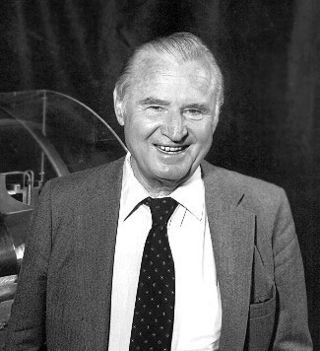
Hans Joachim Pabst von Ohain was a German physicist, engineer, and the designer of the first aircraft to use a turbojet engine. Together with Frank Whittle and Anselm Franz, he has been described as the co-inventor of the turbojet engine. However, the historical timelines show that von Ohain was still a university student when, in January 1930, Whittle filed his first patent for a turbojet engine and successfully tested his first engine in April 1937, some 6 months before von Ohain. Additionally, prior to designing his engine and filing his own patent in 1935, von Ohain had read and critiqued Whittle's patents. Von Ohain stated in his biography that "My interest in jet propulsion began in the fall of 1933 when I was in my seventh semester at Göttingen University. I didn't know that many people before me had the same thought." Unlike Whittle, von Ohain had the significant advantage of being supported by an aircraft manufacturer, Heinkel, who funded his work.

The Junkers Jumo 004 was the world's first production turbojet engine in operational use, and the first successful axial compressor turbojet engine. Some 8,000 units were manufactured by Junkers in Germany late in World War II, powering the Messerschmitt Me 262 fighter and the Arado Ar 234 reconnaissance/bomber, along with prototypes, including the Horten Ho 229. Variants and copies of the engine were produced in Eastern Europe and the USSR for several years following the end of WWII.

The BMW 003 is an early axial turbojet engine produced by BMW AG in Germany during World War II. The 003 and the Junkers Jumo 004 were the only German turbojet engines to reach production during World War II.

The Rolls-Royce RB.80 Conway was the first turbofan jet engine to enter service. Development started at Rolls-Royce in the 1940s, but the design was used only briefly, in the late 1950s and early 1960s, before other turbofan designs replaced it. The Conway engine was used on versions of the Handley Page Victor, Vickers VC10, Boeing 707-420 and Douglas DC-8-40.

The Rolls-Royce RB.37 Derwent is a 1940s British centrifugal compressor turbojet engine, the second Rolls-Royce jet engine to enter production. It was an improved version of the Rolls-Royce Welland, which itself was a renamed version of Frank Whittle's Power Jets W.2B. Rolls-Royce inherited the Derwent design from Rover when they took over their jet engine development in 1943.

The Rolls-Royce RB.23 Welland was Britain's first production jet engine. It entered production in 1943 for the Gloster Meteor. The name Welland is taken from the River Welland, in keeping with the Rolls-Royce policy of naming early jet engines after rivers based on the idea of continuous flow, air through the engine and water in a river.
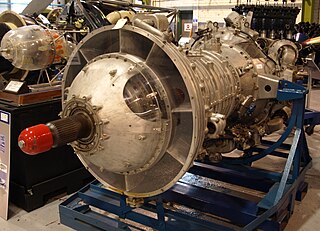
The Rolls-Royce RB.39 Clyde was Rolls-Royce's first purpose-designed turboprop engine and the first turboprop engine to pass its civil and military type-tests.
Alan Arnold Griffith, was an English engineer and the son of Victorian science fiction writer George Griffith. Among many other contributions, he is best known for his work on stress and fracture in metals that is now known as metal fatigue, as well as being one of the first to develop a strong theoretical basis for the jet engine. Griffith's advanced axial-flow turbojet engine designs were integral in the creation of Britain's first operational axial-flow turbojet engine, the Metropolitan-Vickers F.2, which first ran successfully in 1941. Griffith, however, had little direct involvement in actually producing the engine, after he moved in 1939 from leading the engine department at the Royal Aircraft Establishment to start work at Rolls-Royce.
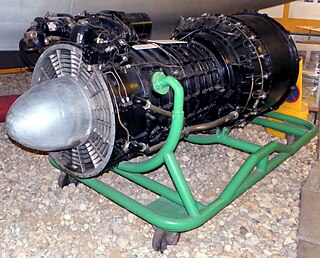
The Metropolitan-Vickers F.2 is an early turbojet engine and the first British design to be based on an axial-flow compressor. It was an extremely advanced design for the era, using a nine-stage axial compressor, annular combustor, and a two-stage turbine.

The Armstrong Siddeley Sapphire is a British turbojet engine that was produced by Armstrong Siddeley in the 1950s. It was the ultimate development of work that had started as the Metrovick F.2 in 1940, evolving into an advanced axial flow design with an annular combustion chamber that developed over 11,000 lbf (49 kN). It powered early versions of the Hawker Hunter and Handley Page Victor, and every Gloster Javelin. Production was also started under licence in the United States by Wright Aeronautical as the J65, powering a number of US designs. The Sapphire's primary competitor was the Rolls-Royce Avon.

The Heinkel HeS 011 or Heinkel-Hirth 109-011(HeS - Heinkel Strahltriebwerke) was an advanced World War II jet engine built by Heinkel-Hirth. It featured a unique compressor arrangement, starting with a low-compression impeller in the intake, followed by a "diagonal" stage similar to a centrifugal compressor, and then a three-stage axial compressor. Many of the German jet-powered aircraft being designed near the end of the war were designed to use the HeS 011, but the engine itself was not ready for production before the war ended in Europe and only small numbers of prototypes were produced.

The Rolls-Royce RB.50 Trent was the first Rolls-Royce turboprop engine.
Between 1936 and 1940 Alan Arnold Griffith designed a series of turbine engines that were built under the direction of Hayne Constant at the Royal Aircraft Establishment (RAE). The designs were advanced for the era, typically featuring a "two-spool" layout with high- and low-pressure compressors that individually had more stages than typical engines of the era. Although advanced, the engines were also difficult to build, and only the much simpler "Freda" design would ever see production, as the Metrovick F.2 and later the Armstrong Siddeley Sapphire. Much of the pioneering work would be later used in Rolls-Royce designs, starting with the hugely successful Rolls-Royce Avon.
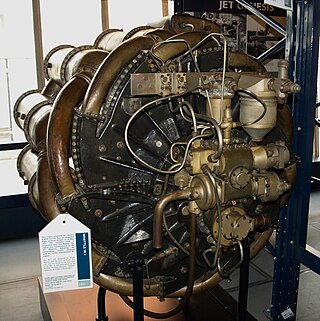
Power Jets was a British company set up by Frank Whittle for the purpose of designing and manufacturing jet engines. The company was nationalised in 1944, and evolved into the National Gas Turbine Establishment.

The Power Jets W.1 was a British turbojet engine designed by Frank Whittle and Power Jets. The W.1 was built under contract by British Thomson-Houston (BTH) in the early 1940s. It is notable for being the first British jet engine to fly, as the "Whittle Supercharger Type W1", powering the Gloster E.28/39 on its maiden flight at RAF Cranwell on 15 May 1941. The W.1 was superseded by the Power Jets W.2.
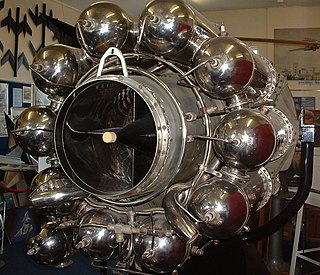
The Power Jets W.2 was a British turbojet engine designed by Frank Whittle and Power Jets Ltd. Like the earlier Power Jets W.1, the reverse-flow combustion configuration included a double-sided centrifugal compressor, 10 combustion chambers and an axial-flow turbine with air-cooled disc. It entered production as the Rolls-Royce Welland and was the first UK jet engine to power operational aircraft, the Gloster Meteor.
The General Electric I-A was the first working jet engine in the United States, manufactured by General Electric (GE) and achieving its first run on April 18, 1942.




















